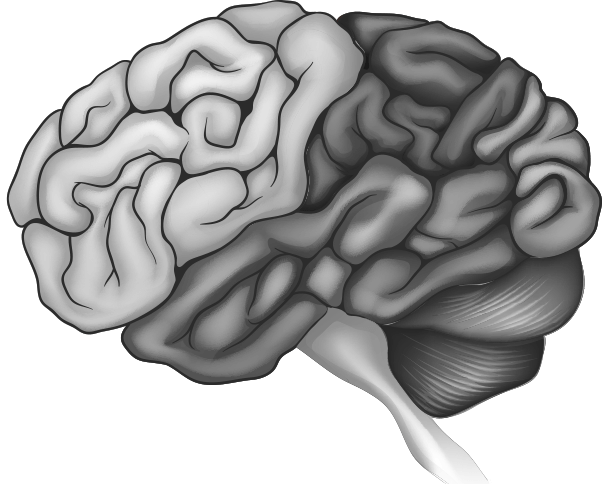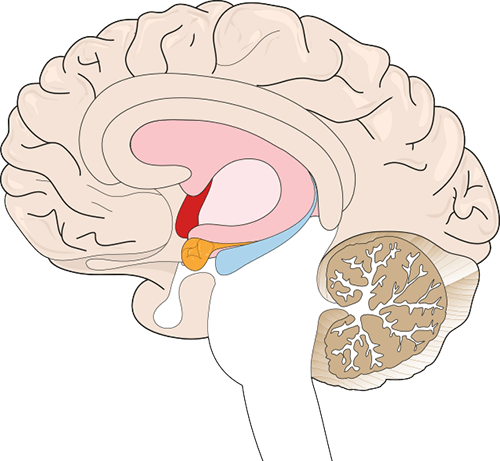"They have been absolutely superb. I can’t praise them highly enough, because I wouldn’t be where I am now if it hadn’t been for them."
– Diane, client's wife
The brain is a vastly complex area of study, and there are still many unanswered questions about how it works.
However, modern science is progressing at an incredible rate and new discoveries are continuously leading us to a greater understanding.
Read on to find out more about the brain.
The brain is made up of four sections, or lobes. These lobes interact with one another to perform the complex functions that we take for granted.
Frontal lobe
The frontal lobe is the most recently evolved area of our brain. This section of the brain is what is believed to be largely responsible for problem solving, reasoning, impulse control and judgement. This allows the frontal lobe to exercise control over the powerful emotional responses that is generated by other parts of the brain. For example, during the caveman era it was perhaps an evolutionary necessity to enter an uncontrollable rage when fighting for survival. This is no longer the case, and the frontal lobe allows us to control our emotions, rather than the other way around.
The frontal lobe is also associated with ‘higher emotions’. One example of this would be empathy, which is the ability to view something from another’s point of view, and then draw your own conclusion based on that information. Another example would be our ability to look beyond actions that lead to immediate gratification, and instead seek out a long-term goal. 
Occipital lobe
The occipital lobe is the area of the brain that is largely responsible for our visual perception system. It converts the information from our eyes into things like depth perception, interpreting colours, and detecting motion. Damaging this area of the brain can lead to a reduce field of vision, blindness, loss of balance and coordination, or even hallucinations.
Parietal lobe
The parietal lobe is responsible for combining the information from all of our different senses (especially touch) to form a general understanding or perception of ourselves, and the world around us. For example if you touch something that is too hot, the parietal lobe processes processes this information and draws that conclusion. This lobe is important for relative spatial awareness, and so it plays a part in skills like drawing, manipulation of objects, and mathematics.
Temporal lobe
The temporal lobe plays a key role in the formation and understanding of our long-term memories. It is also involved in interpreting visual information from our eyes, because we must use our memories to comprehend the full meaning of what we see. For example, when you see a mobile phone you can only know to label it as such because of your past experiences with them. Another example would be how communication relies on the memories associated with verbal sounds.
HypothalamusThe hypothalamus is a part of the brain that is currently associated with things like combativeness, sexuality, thermal regulation, thirst and hunger. Those behaviours are linked to powerful emotions, and it is the current medical understanding that the hypothalamus plays a part in emotions such as rage and pleasure. It has also been suggested that the logical extension of this is that the hypothalamus plays a part in controlling the feelings associated with these emotions, such as displeasure or disgust. One key distinction is that the hypothalamus is linked to the expression of emotions, rather than the generation of them. There are however certain situations where it is directly responsible for creating feelings of panic and anxiety.
One key distinction is that the hypothalamus is linked to the expression of emotions, rather than the generation of them. There are however certain situations where it is directly responsible for creating feelings of panic and anxiety.
Amygdala The amygdala is located within the temporal lobe and is responsible for the creation of emotions. The amygdala controls such emotions such as affection, friendship, love, rage, aggression and fear. These emotions are very important to our ability to judge situations. For example, when a tiger is running towards us we feel fear and know that it is dangerous. Without the amygdala to associate emotions to a situation at hand, we would not know how to judge or respond to it. The most famous response controlled by the amygdala is the ‘fight or flight’ response.
Hippocampus The hippocampus is also located within the temporal lobe, and is associated with the creation and interpretation of long-term memories. For example, if you have a memory of being seasick in the past, the hippocampus would cause other areas of the brain to associate displeasure to travelling on boats. Without a functioning hippocampus, it would not be possible to associate emotions to your memories.
Severe injury to the hippocampus can be devastating to the injured person's lifestyle, because all of their previous experiences would no longer have any ‘meaning’ to them. It would be painful indeed to find that your husband or wife, despite being able to remember their wedding day, does not associate any feelings of love of joy with it.
ThalamusThe thalamus is the central relay point for the hypothalamus, amygdala and hippocampus. Each of these three structures must act in unison to form the limbic system, which are the processes involved in motivation, emotions, memories, and learning. Without all three structures acting in unison, as coordinated by the thalamus, the limbic system does not perform correctly.
The brain is so important yet so delicate, and damage to it is very often life-changing. To learn more, visit types of brain injury.